

Pindar. Plato Quotes. Poetry is nearer to vital truth than history.

The direction in which education starts a man will determine his future life. 7. Plato, Part II: Arguments for the immortality of the soul. Theory of Forms. Plato's theory of Forms or theory of Ideas[1][2][3] asserts that non-material abstract (but substantial) forms (or ideas), and not the material world of change known to us through sensation, possess the highest and most fundamental kind of reality.[4] When used in this sense, the word form or idea is often capitalized.[5] Plato speaks of these entities only through the characters (primarily Socrates) of his dialogues who sometimes suggest that these Forms are the only true objects of study that can provide us with genuine knowledge; thus even apart from the very controversial status of the theory, Plato's own views are much in doubt.[6] Plato spoke of Forms in formulating a possible solution to the problem of universals.

Forms[edit] Platonic Forms. This is a concise introduction to Plato’s use of the concept of “Form,” which many readers initially find to be puzzling, or even an egregious affront to common sense.

The following is not intended to defend Plato’s theory as an adequate response to the problems it was designed to address. It is intended only to show that the theory is an intelligible and reasonable response to those problems. Plato assumes, following Parmenides, that what is real may be thought and what is thought may be said. In other words, reality may be known through rational inquiry or thinking and the resultant thoughts may be communicated propositionally. But how do linguistically expressed judgments convey truths about non-linguistic realities?
Forms as class concepts. Much can be said in favor of this way of thinking. Forms as standards. Our knowledge of Forms. The Cave: An Adaptation of Plato's Allegory in Clay. Happy Birthday, Sartre: Why "Being-in-the-World-Ness" is the Key to the Imagination. The Imaginary (Sartre) The Imaginary: A Phenomenological Psychology of the Imagination (French: L'Imaginaire) is a 1940 book by Jean-Paul Sartre that propounds his concept of the imagination and discusses what the existence of imagination shows about the nature of human consciousness.
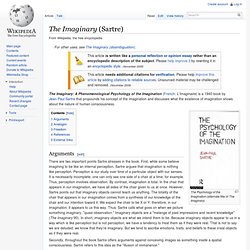
The Psychology of the Imagination (alternate title of The Imaginary) There are two important points Sartre stresses in the book. First, while some believe imagining to be like an internal perception, Sartre argues that imagination is nothing like perception. Perception is our study over time of a particular object with our senses. It is necessarily incomplete; one can only see one side of a chair at a time, for example. Secondly, throughout the book Sartre offers arguments against conceiving images as something inside a spatial consciousness. Outline of Argument from Recollection. The Argument from Recollection: Phaedo 72e-77a 1.
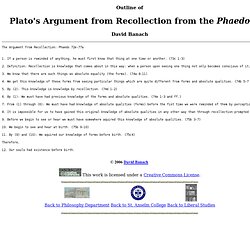
If a person is reminded of anything, he must first know that thing at one time or another. (73c 1-3) 2. Definition: Recollection is knowledge that comes about in this way: when a person upon seeing one thing not only becomes conscious of it, but also of something else which is a different object of knowledge. (73c 5-10) 3. 4. 5. 6. 7. 8. 8. Plato, Part III: Arguments for the immortality of the soul (cont.) Science - Quantum Physics of Consciousness and Physical Reality by StarStuffs. We may therefore regard matter as being constituted by the regions of space in which the field is extremely intense...There is no place in this new kind of physics for the field and matter, for the field is the only reality.
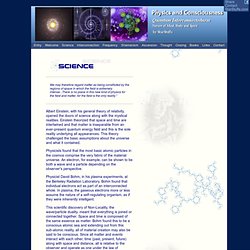
" Albert Einstein, with his general theory of relativity, opened the doors of science along with the mystical realities. Einstein theorized that space and time are intertwined and that matter is inseparable from an ever-present quantum energy field and this is the sole reality underlying all appearances. This theory challenged the basic assumptions about the universe and what it contained. Physicists found that the most basic atomic particles in the cosmos comprise the very fabric of the material universe. An electron, for example, can be shown to be both a wave and a particle depending on the observer's perspective. This scientific discovery of Non-Locality, the wave/particle duality, meant that everything is joined or connected together.
Symphony of Science - the Quantum World! Symphony of Science - 'We Are All Connected' (ft. Sagan, Feynman, deGrasse Tyson & Bill Nye) Quantum nonlocality. Quantum nonlocality is the phenomenon by which the measurements made at a microscopic level necessarily refute one or more notions (often referred to as local realism) that are regarded as intuitively true in classical mechanics.
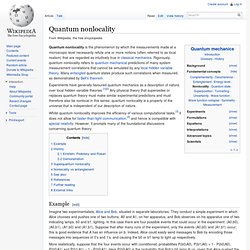
Rigorously, quantum nonlocality refers to quantum mechanical predictions of many-system measurement correlations that cannot be simulated by any local hidden variable theory. Many entangled quantum states produce such correlations when measured, as demonstrated by Bell's theorem. Experiments have generally favoured quantum mechanics as a description of nature, over local hidden variable theories.[1][2] Any physical theory that supersedes or replaces quantum theory must make similar experimental predictions and must therefore also be nonlocal in this sense; quantum nonlocality is a property of the universe that is independent of our description of nature.
Example[edit] Imagine two experimentalists, Alice and Bob, situated in separate laboratories. And P(b0|A1) = Quantum entanglement. Quantum entanglement is a physical phenomenon that occurs when pairs or groups of particles are generated or interact in ways such that the quantum state of each particle cannot be described independently – instead, a quantum state may be given for the system as a whole.

Such phenomena were the subject of a 1935 paper by Albert Einstein, Boris Podolsky and Nathan Rosen,[1] describing what came to be known as the EPR paradox, and several papers by Erwin Schrödinger shortly thereafter.[2][3] Einstein and others considered such behavior to be impossible, as it violated the local realist view of causality (Einstein referred to it as "spooky action at a distance"),[4] and argued that the accepted formulation of quantum mechanics must therefore be incomplete. History[edit] Earth's mantle helps hunt for fifth force of nature. Interactions NASAElectrons' spin may give rise to a force that allows particles to interact over very long distances.
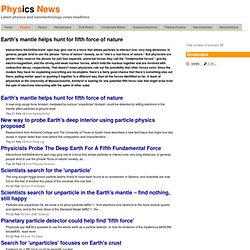
In general, people tend to use the phrase "force of nature" loosely, as in "she's a real force of nature. " But physicists are pickier--they reserve the phrase for just four separate, universal forces they call the "fundamental forces": gravity, electro-magnetism, and the strong and weak nuclear forces, which hold the nucleus together and are involved with radioactive decay, respectively. "Is the Cosmos a Vast Computer Simulation?" New Theory May Offer Clues. If the cosmos is a numerical simulation, there ought to be clues in the spectrum of high energy cosmic rays.
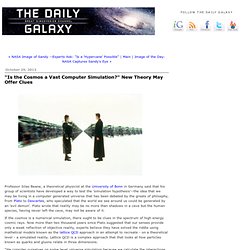
Now more than two thousand years since Plato suggested that our senses provide only a weak reflection of objective reality, experts believe they have solved the riddle using mathetical models known as the lattice QCD approach in an attempt to recreate - on a theoretical level - a simulated reality. Lattice QCD is a complex approach that that looks at how particles known as quarks and gluons relate in three dimensions. "We consider ourselves on some level universe simulators because we calculate the interactions of particles by basically replacing space and time by a grid and putting it in a box," said Beane.
Simulated reality. Simulated reality is the hypothesis that reality could be simulated—for example by computer simulation—to a degree indistinguishable from "true" reality. It could contain conscious minds which may or may not be fully aware that they are living inside a simulation. This is quite different from the current, technologically achievable concept of virtual reality. Virtual reality is easily distinguished from the experience of actuality; participants are never in doubt about the nature of what they experience. Simulated reality, by contrast, would be hard or impossible to separate from "true" reality. UNMAKEABLELOVE. Indra's net. "Imagine a multidimensional spider's web in the early morning covered with dew drops.
And every dew drop contains the reflection of all the other dew drops. And, in each reflected dew drop, the reflections of all the other dew drops in that reflection. “The Precession of Simulacra” by Jean Baudrillard, Translated from English into American. Continent. 2.2 (2012): 99–135 Originally appeared in Baudrillard’s Simulations and Simulacra, 1981. This adaptation is based on an English translation by Paul Foss and Paul Patton. 9. Plato, Part IV: Arguments for the immortality of the soul (cont.) Physicalism. Physicalism is closely related to materialism. Physicalism grew out of materialism with the success of the physical sciences in explaining observed phenomena.
The terms are often used interchangeably, although they are sometimes distinguished, for example on the basis of physics describing more than just matter (including energy and physical law). Common arguments against physicalism include both the philosophical zombie argument[3] and the multiple observers argument,[4] that the existence of a physical being may imply zero or more distinct conscious entities. Definition of physical[edit] The use of "physical" in physicalism is a philosophical concept and can be distinguished from alternative definitions found in the literature (e.g.
10. Personal identity, Part I: Identity across space and time and the soul theory. 11. Personal identity, Part II: The body theory and the personality theory. 12. Personal identity, Part III: Objections to the personality theory. 13. Personal identity, Part IV; What matters? 14. What matters (cont.); The nature of death, Part I. 15. The nature of death (cont.); Believing you will die. 16. Dying alone; The badness of death, Part I. 17. The badness of death, Part II: The deprivation account. 18. The badness of death, Part III; Immortality, Part I.
19. Immortality Part II; The value of life, Part I. 20. The value of life, Part II; Other bad aspects of death, Part I. 21. Other bad aspects of death, Part II. 22. Fear of death. 23. How to live given the certainty of death. 24. Suicide, Part I: The rationality of suicide. 25. Suicide, Part II: Deciding under uncertainty. 26. Suicide, Part III: The morality of suicide and course conclusion. GTMorrisonCreekTrail_1L.jpg (JPEG Image, 523 × 200 pixels) Jaime Saenz: Five strange poems, and more ...